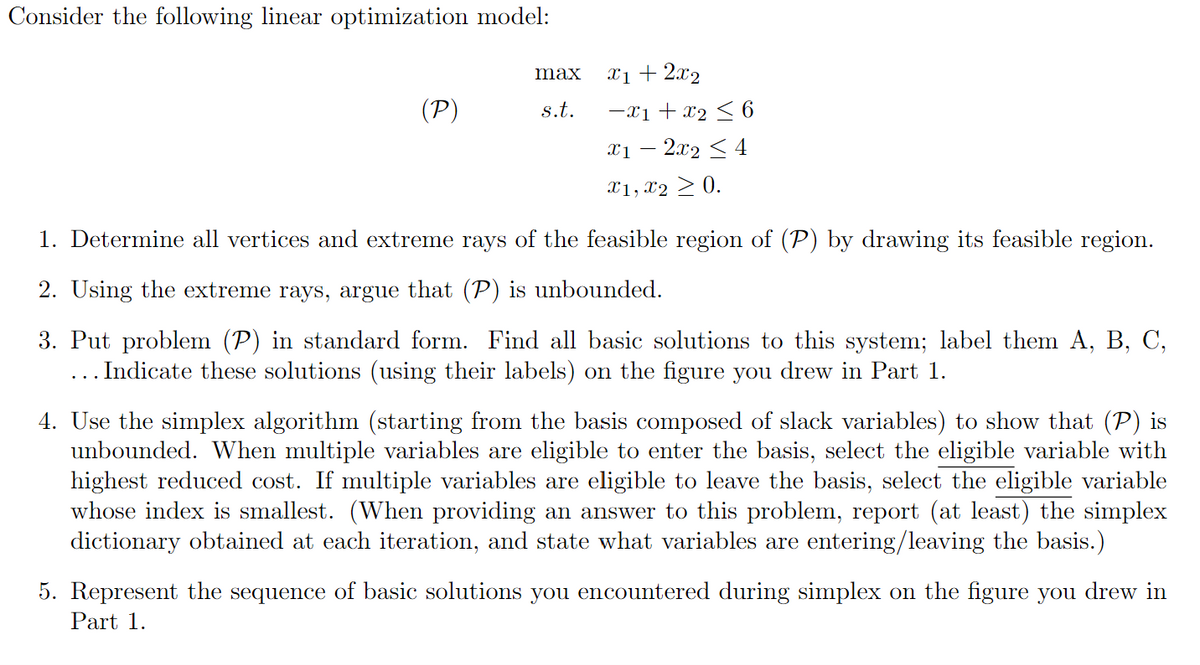Consider the following linear optimization model: (P) max s.t. x1 + 2x₂ -x1+x₂ ≤ 6 x12x2 ≤ 4 X1, X2 ≥ 0. 1. Determine all vertices and extreme rays of the feasible region of (P) by drawing its feasible region. 2. Using the extreme rays, argue that (P) is unbounded. 3. Put problem (P) in standard form. Find all basic solutions to this system; label them A, B, C, ... Indicate these solutions (using their labels) on the figure you drew in Part 1. 4. Use the simplex algorithm (starting from the basis composed of slack variables) to show that (P) is unbounded. When multiple variables are eligible to enter the basis, select the eligible variable with highest reduced cost. If multiple variables are eligible to leave the basis, select the eligible variable whose index is smallest. (When providing an answer to this problem, report (at least) the simplex dictionary obtained at each iteration, and state what variables are entering/leaving the basis.) 5. Represent the sequence of basic solutions you encountered during simplex on the figure you drew in Part 1.
Consider the following linear optimization model: (P) max s.t. x1 + 2x₂ -x1+x₂ ≤ 6 x12x2 ≤ 4 X1, X2 ≥ 0. 1. Determine all vertices and extreme rays of the feasible region of (P) by drawing its feasible region. 2. Using the extreme rays, argue that (P) is unbounded. 3. Put problem (P) in standard form. Find all basic solutions to this system; label them A, B, C, ... Indicate these solutions (using their labels) on the figure you drew in Part 1. 4. Use the simplex algorithm (starting from the basis composed of slack variables) to show that (P) is unbounded. When multiple variables are eligible to enter the basis, select the eligible variable with highest reduced cost. If multiple variables are eligible to leave the basis, select the eligible variable whose index is smallest. (When providing an answer to this problem, report (at least) the simplex dictionary obtained at each iteration, and state what variables are entering/leaving the basis.) 5. Represent the sequence of basic solutions you encountered during simplex on the figure you drew in Part 1.
Algebra for College Students
10th Edition
ISBN:9781285195780
Author:Jerome E. Kaufmann, Karen L. Schwitters
Publisher:Jerome E. Kaufmann, Karen L. Schwitters
Chapter12: Algebra Of Matrices
Section12.CR: Review Problem Set
Problem 35CR: Maximize the function fx,y=7x+5y in the region determined by the constraints of Problem 34.
Related questions
Question
please show full work thanks

Transcribed Image Text:Consider the following linear optimization model:
(P)
max
s.t.
x1 + 2x₂
−X1 + X₂ ≤ 6
x1 − 2x2 ≤ 4
X1, X2 ≥ 0.
1. Determine all vertices and extreme rays of the feasible region of (P) by drawing its feasible region.
2. Using the extreme rays, argue that (P) is unbounded.
3. Put problem (P) in standard form. Find all basic solutions to this system; label them A, B, C,
... Indicate these solutions (using their labels) on the figure you drew in Part 1.
4. Use the simplex algorithm (starting from the basis composed of slack variables) to show that (P) is
unbounded. When multiple variables are eligible to enter the basis, select the eligible variable with
highest reduced cost. If multiple variables are eligible to leave the basis, select the eligible variable
whose index is smallest. (When providing an answer to this problem, report (at least) the simplex
dictionary obtained at each iteration, and state what variables are entering/leaving the basis.)
5. Represent the sequence of basic solutions you encountered during simplex on the figure you drew in
Part 1.
Expert Solution
This question has been solved!
Explore an expertly crafted, step-by-step solution for a thorough understanding of key concepts.
This is a popular solution!
Trending now
This is a popular solution!
Step by step
Solved in 4 steps with 71 images

Recommended textbooks for you

Algebra for College Students
Algebra
ISBN:
9781285195780
Author:
Jerome E. Kaufmann, Karen L. Schwitters
Publisher:
Cengage Learning

Algebra: Structure And Method, Book 1
Algebra
ISBN:
9780395977224
Author:
Richard G. Brown, Mary P. Dolciani, Robert H. Sorgenfrey, William L. Cole
Publisher:
McDougal Littell

Algebra for College Students
Algebra
ISBN:
9781285195780
Author:
Jerome E. Kaufmann, Karen L. Schwitters
Publisher:
Cengage Learning

Algebra: Structure And Method, Book 1
Algebra
ISBN:
9780395977224
Author:
Richard G. Brown, Mary P. Dolciani, Robert H. Sorgenfrey, William L. Cole
Publisher:
McDougal Littell